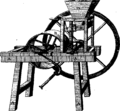William Winlaw

William Winlaw was an 18th-century English agricultural machinery inventor and manufacturer with a factory in Margaret Street, Cavendish Square, London.[2][3][4]
Winlaw produced machine equipment and implements used in agriculture and husbandry.[5] He invented and patented many new machines and pieces of equipment in the late 18th century.[6][7][8] Examples include:[9]
- A mill for separating grain from corn[10]
- A spring and index fixed to a whippletree[11]
- A syringe for watering plants or flowers[12]
At the time of his death in 1796, William Winlaw was described as the "Engine-maker to the Prince of Wales and Duke of Clarence", namely Prince George (1762–1830), later King George IV, and Duke William (1765–1837), later King William IV.[13][4] Winlaw's Will is held by the National Archives in the United Kingdom.[14]
Machinery by William Winlaw[edit]
The following are some machines and implements used in agriculture and husbandry, made by William Winlaw:[2]
References[edit]
- ^ "William Winlaw". The British Museum. Retrieved 23 January 2021.
- ^ a b Winlaw, William (1786). A Description of Some Engines and Implements Used in Husbandry, &c. Made and Sold by William Winlaw, Engine-maker, Margaret-Street, Cavendish-Square, London. John Hay/Gale Ecco. ISBN 978-1140934615. (republished 2010)
- ^ Winlaw, William (1786). "A description of some engines and implements used in husbandry, &c [microform]: made and sold by William Winlaw, engine-maker, Margaret-Street, Cavendish-Square, London". National Library of Australia. Retrieved 23 January 2021.
- ^ a b "From George Washington to Arthur Young, 1 November 1787". Founders Online. United States: National Archives and Records Administration. Retrieved 24 January 2021.
- ^ Andrews, G. H. (1852). Rudimentary treatise on agricultural engineering (PDF). London: J. Weale.
- ^ Ransome, J. A. (1843). The implements of agriculture (PDF). London: J. Ridgway. OCLC 1046652001.
- ^ Chronological index of patentees and applicants for patents of invention (PDF). Vol. 1617. London: Patent Office. 1852.
- ^ Subject-matter index of specifications of patents (PDF). London: Patent Office. 1857.
- ^ Johnson, C. W.; Emerson, G. (1868). "The farmer's and planter's encyclopaedia of rural affairs; embracing all the most recent discoveries in agricultural chemistry, suited to the comprehension of unscientific readers" (PDF). Philadelphia: J. B. Lippincott & Co. OCLC 1045105261.
{{cite journal}}: Cite journal requires|journal=(help) - ^ "A Description of William Winlaw's Mill, for Separating the Grain from the Corn, in Place of Threshing". Annals of Agriculture. 6: 152–155. 1786.
- ^ "Mr. William Winlaw" (PDF). Transactions of the Society, Instituted at London, for the Encouragement of Arts, Manufactures, and Commerce. 8. 1790.
- ^ "Mr. William Winlaw" (PDF). Transactions of the Society, Instituted at London, for the Encouragement of Arts, Manufactures, and Commerce. 10. 1792.
- ^ "William Winlaw". The Morning Post and Fashionable World. London. 8 August 1796.
- ^ "Will of William Winlaw, Engine Maker of Margaret Street Cavendish Square, Middlesex". UK: The National Archives. 2 November 1796. Retrieved 23 January 2021. (ref PROB 11/1282/12)




